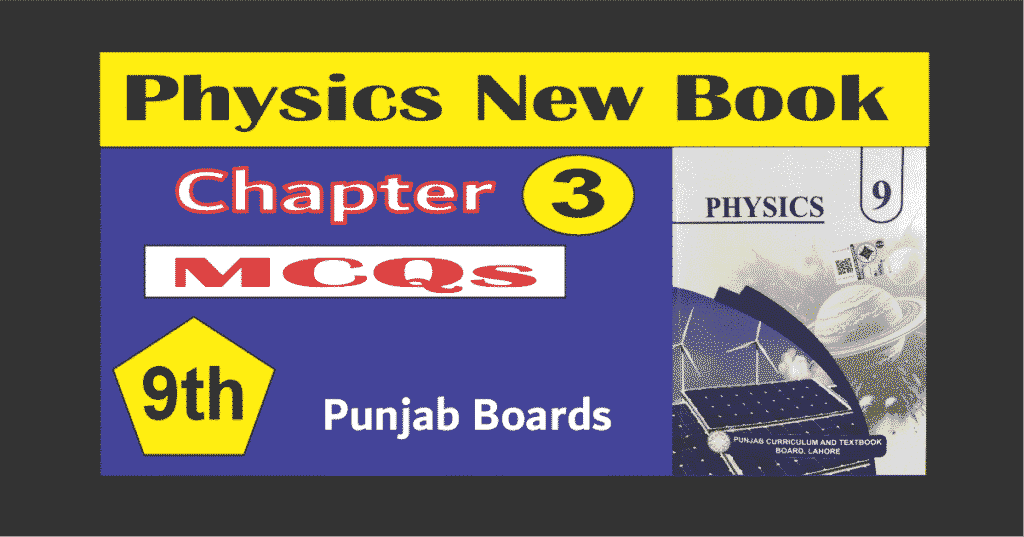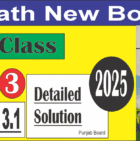9th Physics Chapter3 MCQs | Dynamics
9th Physics Chapter3 MCQs will be checked in detail. 3rd chapter of class 9 physics new book is dynamics
Multiple Choice Questions. Tick the correct answer.
————————————————————————————————————————————————–
3.1 When we kick a stone, we get hurt. This is due to:
(a) inertia (b) velocity (c) momentum (d) reaction
Option ( d ) is correct.
Explanation:- Newton’s Third Law of motion. Action and reaction are equal in magnitude but opposite in direction
————————————————————————————————————————————————–
3.2 An object will continue its motion with constant acceleration until:
(a) the resultant force on it begins to decrease.
(b) the resultant force on it is zero.
(c) the resultant force on it begin to increase.
(d) the resultant force is at right angle to its tangential velocity.
Option (a) is correct.
Explanation: – Newton’s First Law of motion. An object moving with constant speed in straight line continues it unless an external force tries to stop it.
————————————————————————————————————————————————–
3.3 Which of the following is a non-contact force?
(a) Friction (b) Air resistance (c) Electrostatic force (d) Tension in the string
Option (c) is correct.
Explanation: – Non contact force is a force that acts on an object without physical contact.
————————————————————————————————————————————————–
3.4 A ball with initial momentum P hits a solid wall and bounces back with the same velocity. Its momentum after collision will be. Its momentum after collision will be p’ after the collision will be:
(a) p’ = p (b) p’ = – p (c) p’ = 2p (d) p’ = -2p
Option (b) is correct.
Explanation: –
Momentum is a vector, so direction matters.
————————————————————————————————————————————————–
3.5 A particle of mass m moving with a velocity v collides with another particle of the same mass at rest. The velocity of the first particle after collision is:
(a) v (b) -v (c) 0 (d) -1/2
Option (c) is correct.
Explanation: –
The moving particle comes to rest because collision is perfectly elastics and both the particles have equal masses
————————————————————————————————————————————————–
3.6 Conservation of linear momentum is equivalent to:
(a) Newton’s fist law of motion
(b) Newton’s second law of motion
(c) Newton’s third law of motion
(d) None of these
Option (c) is correct
Explanation: – Action and reaction are equal in magnitude but opposite in direction. Before collision is action and after the collision is reaction.
————————————————————————————————————————————————–
3.7 An object with a mass of 5 Kg moves at constant velocity of 10 m . A constant force then acts for 5 seconds on the object and gives it a velocity of 2 m in the opposite direction. The force acting on the object is:
(a) 5N (b) -10N (c) -12 (d) -15
Option (c) is correct.
Explanation:- We got -12 N after applying Newton’s second law of motion and first equation of motion.
Given:
- Mass m=5m = 5 kg
- Initial velocity u=10u = 10 m/s
- Final velocity v=−2v = -2 m/s (opposite direction)
- Time t=5t = 5 s
Using the formula:
$$Newton’s\;2nd\;Law\\F\;=\;ma\\\\1st\;equation\;of\;motion\\V\;=\;U\;+\;at\\\\\frac{V-U}t\;=\;a\\Putting\;in\;2nd\;law\\We\;get\\\\F\;=\;m\;(\frac{V-U}t)$$
$$After\;putting\;the\;values\\We\;get\\\\F\;=\;5\;(\;\frac{-2-10}5)\\F\;=\;5\;(\frac{-12}5)\\\\F\;=\;-12\;N$$
————————————————————————————————————————————————–
3.8 A large force acts on an object for a very short interval of time. In this case, it is easy to determine:
(a) magnitude of force (b) time interval
(c) product of force and time (d) none of these
Option (c) is correct.
Explanation: – we can easily calculate impulse because of large force and short interval of time.
————————————————————————————————————————————————–
3.9 A lubricant is usually introduced between two surfaces to decrease friction. The lubricant:
(a) decreases temperature
(b) acts as ball bearings
(c) prevents direct contact of the surfaces
(d) provides rolling friction
Option (c) is correct.
Explanation: –
A thin layer of lubricant reduces friction because their will be no direct contact between the surfaces.
————————————————————————————————————————————————–
Check! Some useful links below




